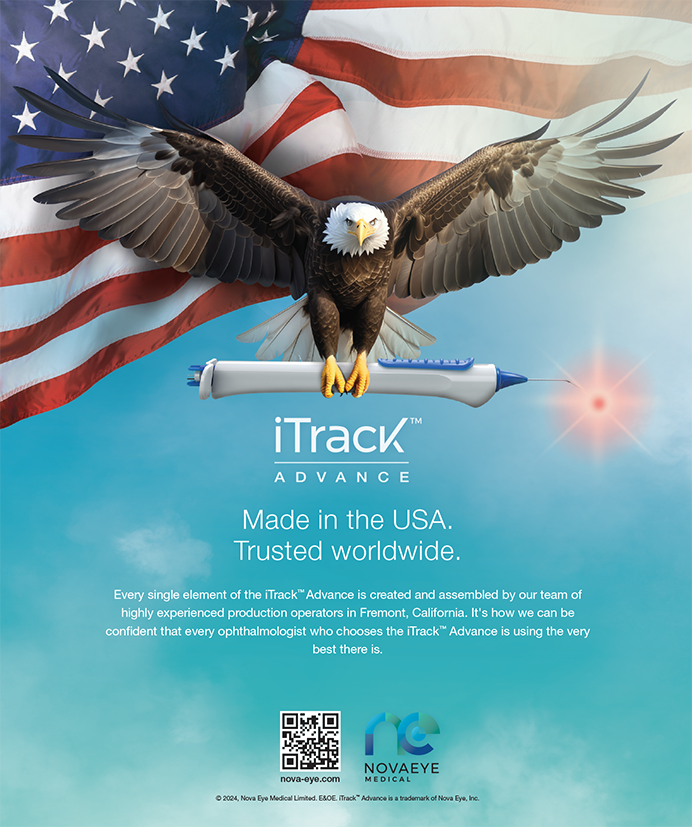


Patient-Reported Vision-Related Quality of Life After Bilateral Wavefront-Guided Laser in Situ Keratomileusis
Chen SP, Manche EE1
ABSTRACT SUMMARY
Investigators evaluated visual outcomes and patient satisfaction ratings for bilateral wavefront-guided LASIK. This prospective cohort study enrolled 50 patients presenting to the Stanford Eye Laser Center for myopic LASIK between April 2014 and February 2016. It excluded patients with less than 250 µm of residual posterior corneal thickness, ocular surface disease, relevant systemic diseases, or large differences between manifest and cycloplegic refractions.
The researchers measured visual acuity, refraction, aberrometry, patient satisfaction, and quality of life (QOL) 1, 6, and 12 months after LASIK. QOL was evaluated using the Refractive Status and Vision Profile (RSVP), a 42-item validated questionnaire for refractive surgery with subcategories in driving, visual function, perception, visual symptoms, problems with corrective lenses, and expectations.2 Visual profile scores were scaled from 0 to 100, with lower scores indicating decreased visual burden.
STUDY IN BRIEF
Investigators found that bilateral wavefront-guided LASIK provided excellent objective outcomes such as visual acuity, refraction, and aberrometry as well as high patient satisfaction and quality of life, as measured by the Refractive Status and Vision Profile questionnaire.
WHY IT MATTERS
The field of refractive surgery has evolved to offer patients a plethora of surgical options for spectacle independence. Recent advances such as the development of wavefront-guided and wavefront-optimized LASIK can help surgeons minimize higher-order aberrations and enhance quality of vision. Given the elective nature of refractive surgery, comparisons of procedures must include both clinical measures of efficacy and patient-reported outcomes. This study used objective measures and one of the first validated refractive quality-of-life questionnaires to demonstrate that bilateral wavefront-guided LASIK yielded high-quality vision.
Of the 50 patients, one canceled surgery, seven were lost to follow-up, and 42 (84 eyes) were included in the study. The mean age of the study patients was 32.4 ±5.5 years, and 22 patients (52.4%) were women. At 12 months, 76 eyes (90.5%) had an uncorrected distance visual acuity (UDVA) of 20/20 or better, and all eyes achieved 20/40 or better. Ninety-nine percent of eyes were within ±0.50 D of emmetropia, and 100% had less than 1.00 D of cylinder. Mean higher-order aberrations (HOAs), including coma, spherical aberration, and root mean square (RMS) errors, increased significantly, whereas mean trefoil trended downward.
Mean total RSVP scores improved from 30.9 before surgery to 20.7 (P < .001) at 12 months, primarily due to decreased subscores for visual function, perception, and problems with corrective lenses. Patients reported being better able to watch television, read, or work; feeling less concern about or frustration with their vision; and no longer worrying about the maintenance of their corrective lenses. They reported no difference in vision quality while driving or visual symptoms such as eye irritation or photophobia.
Five patients (11.9%) were dissatisfied or very dissatisfied with their visual acuity at 12 months. There was no difference in age, sex, UDVA, low-contrast vision, or refraction between dissatisfied and satisfied patients. Dissatisfied patients had higher mean trefoil (0.15 ±0.09 vs 0.11 ±0.05, P = .028) and RMS error (100% vs 68.9% over 0.03 µm, P = .039) compared with satisfied patients, although these findings lost significance after Bonferroni correction.
DISCUSSION
The investigators found that bilateral wavefront-guided LASIK produced excellent visual acuity, refractive, and aberrometric outcomes. In this study, 90.5% of patients achieved UDVA of 20/20 or better compared with rates of 91% to 99% reported in other studies of wavefront-guided LASIK. In this study by Chen and Manche, 99% of patients were within ±0.50 D of the spherical equivalent target refraction compared with 97% to 100% in other studies.3-6 HOAs including coma, spherical aberration, and RMS error showed a small but significant increase after the procedure. Although HOAs increase after wavefront-guided LASIK, previous studies have shown that wavefront-guided LASIK induces fewer HOAs than conventional LASIK and femtosecond laser-assisted LASIK.3,7
QOL, as measured by the RSVP, significantly improved after surgery, owing to better visual function and fewer problems with corrective lenses. Nevertheless, 11.9% of patients were dissatisfied at 12 months compared with a dissatisfaction rate of 2% to 5% reported in other studies.8,9 Chen and Manche postulated that their finding might have resulted from differences in survey format, namely the lack of a “somewhat satisfied” option that was available in other studies. The cohort of dissatisfied patients had higher mean trefoil and RMS errors compared with satisfied patients. Although this study might not have sufficient power to detect additional risk factors, previous research found that worse postoperative UDVA and the presence of photic visual phenomena are associated with patient dissatisfaction.
Published in 2000, the RSVP is the first questionnaire specifically composed for refractive surgery and one of the most commonly used, with strong internal consistency and responsiveness to QOL changes after surgery. Since its publication, a dozen additional questionnaires have been developed, including the Quality of Life Impact of Refractive Correction and the widely used National Eye Institute Refractive Quality of Life. These questionnaires vary widely in their coverage of QOL domains, validity, reliability, and psychometric properties.10 With myriad options, it is important for researchers to select an appropriate patient assessment tool that aligns with the goals and parameters of each patient population. Further study is required to develop a standardized, comprehensive QOL assessment tool for the evaluation of refractive surgery.
Biomechanics of LASIK Flap and SMILE Cap: a Prospective, Clinical Study
Khamar P, Shetty R, Vaishnav R, Francis M, Nuijts RMMA, Roy AS11
ABSTRACT SUMMARY
Investigators conducted a biomechanical analysis of the corneas of 24 patients who underwent LASIK in one eye and SMILE in the fellow eye. A stable refraction, moderate myopia, adequate central corneal thickness, and an absence of generally accepted contraindications such as keratoconus were inclusion criteria for this prospective, interventional, longitudinal case series.
STUDY IN BRIEF
Keratorefractive surgery produced alterations in corneal biomechanics that might predispose some patients to ectasia or other complications postoperatively. This prospective case series provided the first comparison of differential changes in corneal biomechanics due solely to the unique geometries of the surgical planes developed by femtosecond laser photodisruption during LASIK and SMILE.
WHY IT MATTERS
Postoperative ectasia is a rare but devastating complication of refractive surgery. Some have contended that SMILE decreases the risk of postoperative ectasia by leaving native corneal biomechanics relatively undisturbed as compared with LASIK, and the comparative analysis of corneal biomechanics in LASIK and SMILE is an active area of clinical research.13 This study’s novel design helped to distinguish biomechanical changes induced by flap or cap creation from those induced by subsequent tissue removal and remodeling.
The investigators assessed the biomechanical changes induced by flap or cap cut alone prior to structural alteration of the tissue by photoablation or lenticule extraction, respectively. They also attempted to determine which surgical plane geometry (ie, flap or cap) induced a greater overall biomechanical change by comparing the proportion of biomechanical variables that were significantly altered in each group. Deformation responses were obtained using the Corvis ST (Oculus Optikgeräte), an instrument that combines high-speed Scheimpflug imaging with noncontact tonometry. Measurements were taken preoperatively, immediately after creation of the flap or cap with a femtosecond laser (but prior to tissue removal), and at 1 and 4 weeks after surgery.
Biomechanical parameters were either derived from waveform analysis of the entire deformation amplitude signal12 (eg, corneal stiffness) or measured at geometrically and temporally defined phases of the deformation response—first applanation, highest concavity, and second applanation. In total, 30 primary biomechanical variables were recorded and analyzed at each time point.
As expected, both flap and cap creation alone altered deformation variables in a manner consistent with biomechanical weakening (eg, decreased corneal stiffness). For several variables, tissue removal and postoperative tissue remodeling produced additional changes beyond those induced by the flap or cap cut alone. The proportion of variables that demonstrated early biomechanical changes was higher after flap creation in LASIK than after cap creation in SMILE. At postoperative weeks 1 and 4, however, variables identified a similar magnitude of change in eyes undergoing LASIK and SMILE, which indicated both that tissue removal and remodeling exerted a greater effect on corneal biomechanics than surgical plane geometry and that the effect was similar in LASIK and SMILE.
DISCUSSION
Khamar et al demonstrated that it is possible to measure the alteration of corneal biomechanics immediately after flap and cap creation but prior to tissue removal, and they found that the effects of flap or cap creation alone were often significant. Alterations in corneal biomechanics can therefore be conceptualized as belonging to two groups: those occurring immediately after flap or cap creation and those occurring as a result of tissue removal and subsequent tissue remodeling.
A major finding of this study is that flap creation in LASIK weakens the cornea more than cap creation in SMILE, and this conclusion was based on a statistical analysis of the proportion of Corvis ST–measured variables that were altered before tissue removal. An underlying assumption that the researchers readily acknowledged was that this proportion was a valid surrogate for overall biomechanical weakening, but no validation or reference for the use of this proportion as a marker of relative corneal weakness was provided. This is problematic because the methodology made no distinctions among the 30 variables that were measured, even though some variables were probably more likely than others to predispose an eye to ectasia. Additionally, no direct statistical comparison of the magnitudes of change for any given variable in LASIK versus SMILE was provided. The investigators simply stated that these were similar between LASIK and SMILE postoperatively, so any conclusions about the superiority of SMILE over LASIK from the perspective of postoperative corneal weakening must be tempered. Nonetheless, the researchers provided a novel contribution to the study of corneal biomechanics after refractive surgery by demonstrating that alterations due to surgical plane geometry alone could be readily measured with the Corvis ST.
1. Chen SP, Manche EE. Patient-reported vision-related quality of life after bilateral wavefront-guided laser in situ keratomileusis. J Cataract Refract Surg. 2019;45(6):752-759.
2. Vitale S, Schein OD, Meinert CL, Steinberg EP. The refractive status and vision profile: a questionnaire to measure vision-related quality of life in persons with refractive error. Ophthalmology. 2000;107(8):1529-1539.
3. Zheng Y, Zhou YH, Zhang J, et al. Comparison of visual outcomes after femtosecond LASIK, wavefront-guided femtosecond LASIK, and femtosecond lenticule extraction. Cornea. 2016;35(8):1057-1061.
4. Moussa S, Dexl AK, Krall EM, Arlt EM, Grabner G, Ruckhofer J. Visual, aberrometric, photic phenomena, and patient satisfaction after myopic wavefront-guided LASIK using a high-resolution aberrometer. Clin Ophthalmol. 2016;10:2489-2496.
5. Khalifa MA, Alsahn MF, Shaheen MS, Pinero DP. Comparative analysis of the efficacy of astigmatic correction after wavefront-guided and wavefront-optimized LASIK in low and moderate myopic eyes. Int J Ophthalmol. 2017;10(2):285-292.
6. Moussa S, Dexl A, Krall EM, et al. Comparison of short-term refractive surgery outcomes after wavefront-guided versus non-wavefront-guided LASIK. Eur J Ophthalmol. 2016;26(6):529-535.
7. Ye MJ, Liu CY, Liao RF, Gu ZY, Zhao BY, Liao Y. SMILE and wavefront-guided LASIK out-compete other refractive surgeries in ameliorating the induction of high-order aberrations in anterior corneal surface. J Ophthalmol. 2016;2016:8702162.
8. Eydelman M, Hilmantel G, Tarver ME, et al. Symptoms and satisfaction of patients in the patient-reported outcomes with laser in situ keratomileusis (PROWL) studies. JAMA Ophthalmol. 2017;135(1):13-22.
9. Yu J, Chen H, Wang F. Patient satisfaction and visual symptoms after wavefront-guided and wavefront-optimized LASIK with the WaveLight platform. J Refract Surg. 2008;24(5):477-486.
10. Kandel H, Khadka J, Lundström M, Goggin M, Pesudovs K. Questionnaires for measuring refractive surgery outcomes. J Refract Surg. 2017;33(6):416-424.
11. Khamar P, Shetty R, Vaishnav R, Francis M, Nuijts RMMA, Sinha Roy A. Biomechanics of LASIK flap and SMILE cap: a prospective, clinical study. J Refract Surg. 2019;35(5):324-332.
12. Francis M, Pahuja N, Shroff R, et al. Waveform analysis of deformation amplitude and deflection amplitude in normal, suspect, and keratoconic eyes. J Cataract Refract Surg. 2017;43(10):1271-1280.
13. Shetty R, Francis M, Shroff R, et al. Corneal biomechanical changes and tissue remodeling after SMILE and LASIK. Invest Ophthalmol Vis Sci. 2017;58(13):5703-5712.




